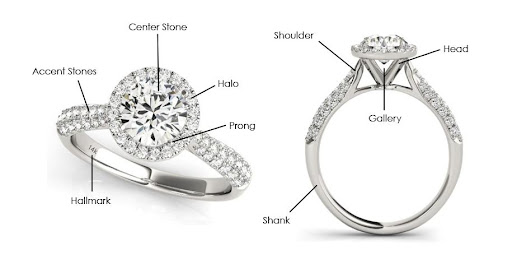
As a newly engaged person, you're likely to face a lot of new terminology and information overload. Engagement rings may appear simple, but they're actually made up of a lot of distinct components. There is a specific phrase for each location that is utilized by jewelers and has a specific purpose. So, let's have a look at a few of the terms used in this unusual context.
In today's engagement rings, there is one thing that they all have in common. There is a stone in the middle that is larger than the others. Diaomonds and gemstones are also acceptable options. Carats are used to quantify the weight of a center stone, with a 1 carat stone being the most prevalent in the United States. Round is the most common shape, although other shapes including emerald, pear, marquise, cushion, and princess are also popular; they are known as "fancy" shapes. Every shape has its own set of advantages and disadvantages.
The side stones might be any of the following shapes.. A three stone setting has two stones on either side of the central stone. Depending on the side stones selected, this will raise the price of the setting. Gemstones like sapphire and emerald are gorgeous alternatives to diaomonds, but they are less expensive. Choose diaomonds that are of the same quality as the main stone if you want your ring to have a more coordinated appearance. The meaning of the three stone setting is to represent love, loyalty, and friendship.
Everything but the center stone is included in the setting. To put it another way, think of the environment as a supporting cast for the star of the show: the central stone. The ring's setting conveys the ring's general style, whether it's historical, contemporary, or classic.
The prongs and the section of the setting that contains the central stone are together referred to as the "head" or "crown" by jewelers. Prongs can come in a variety of forms and sizes to accommodate different sorts of stones. It is frequently known to as the basket if it has a fancy design motif or stones on it, which increases the support and stability for the center stone. Heads can be interchanged with different styles and sizes while preserving the shank or band of the ring.
Even though it isn't required, the use of a halo has been increasingly popular in recent years. The word refers to a ring of stones that surrounds the central stone. The result is that the center of the piece appears larger, and there is an abundance of shine as well.
The gallery is the portion of the ring that can be seen from the side. There is a wide range of styles to choose from, from simple and elegant to ornate and embellished. Here are a few examples of various galleries, both simple and complex, to get you started.
The underside of the gallery is referred to as the bridge, and it can be simple, millgrain, or studded with diaomonds or other precious gems in any combination.
The ring's upper two sides, which create the shank's commencement, are referred to as the shoulder. This section can be straight, twisted, or split, or it can taper or augment.
Shank
It is positioned at the bottom of the ring and can be customized to fit your finger perfectly.
For this reason, as you begin your search for the perfect engagement ring, it's critical that you have a firm grasp on the phrases listed above. If you intend to modify or create a new design, this will be particularly useful.
Sell your diamonds with ease with Diamond Registry’s comprehensive approach and vast global industry connections to help you find the best buyer for your diamond fast. Visit www.diamondregistry.com/sell-your-ring to take your first step to fast, easy and reliable way of selling your diamond.
Want to check and calculate diamond per carat instantly? Go to DR’s diamond price calculator www.diamondregistry.com/diamond-price-list/#calc-move-to to know how. Reliable and trusted carat calculator in the diamond industry since!

